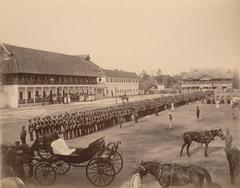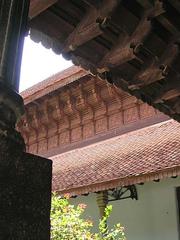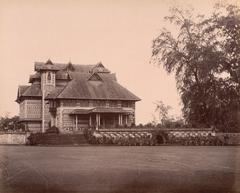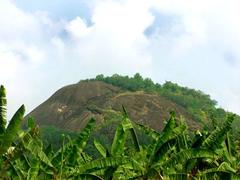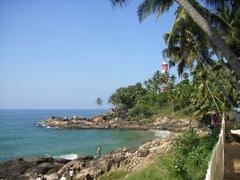Kerala Government Secretariat: Visiting Hours, Tickets & Historical Significance in Thiruvananthapuram
Date: 03/07/2025
Introduction
The Kerala Government Secretariat, situated in the heart of Thiruvananthapuram, stands as both the administrative core of the state and a monumental testament to Kerala’s rich historical, architectural, and political legacy. Established during the reign of Maharaja Ayilyam Thirunal Rama Varma in the late 19th century, the building has witnessed Kerala’s transformation from the princely state of Travancore into a modern democratic state post-1956. Its unique blend of Palladian, Romano-Dutch, and traditional Kerala architectural styles reflects the cosmopolitan influences that have shaped the region. Today, the Secretariat serves as a must-visit destination for history enthusiasts, architecture lovers, and travelers eager to explore Thiruvananthapuram’s historical sites.
For comprehensive visitor information, architectural insights, and historical context, refer to official Kerala government resources and tourism portals such as Kerala Tourism and the Government of Kerala’s General Administration Department.
Table of Contents
- Introduction
- Historical Origins
- Architectural Significance
- Governance Role
- Visiting Hours, Tickets & Accessibility
- Entry Procedures & Security
- Key Architectural Features
- The Durbar Hall
- Facade & External Features
- Expansion & Modernization
- Civic Symbolism
- Visitor Experience & Tips
- Special Events & Photography
- Nearby Attractions
- Frequently Asked Questions
- Conclusion
- References
Historical Origins
The Kerala Government Secretariat was conceived and constructed during the reign of Maharaja Ayilyam Thirunal Rama Varma (1860–1880), an era marked by modernization and administrative reforms in the Travancore kingdom (ekeralatourism.net). Completed in 1869 under the supervision of Diwan T. Madhava Rao, the building originally housed the public offices of Travancore State. Its establishment marked the consolidation of state administration—a legacy that continued through the formation of Travancore-Cochin in 1949 and the state of Kerala in 1956 (Kerala Tourism; GAD Kerala).
Architectural Significance
Designed by Chief Engineer William Barton, the Secretariat exemplifies a harmonious fusion of Palladian, Roman, Dutch, and indigenous Kerala architectural elements (Kerala Tourism). The imposing central block, with its stately colonnades, symmetrical proportions, and clock tower, is a hallmark of neoclassical design. High ceilings, wide verandahs, and sloping tiled roofs are practical adaptations for Kerala’s tropical climate.
The structure rests on a granite foundation and uses locally sourced burnt bricks and wood for durability—particularly important during Kerala’s heavy monsoon seasons. The Secretariat complex has expanded over time, with newer blocks and annexes complementing the original structure’s grandeur (GAD Kerala).
Governance Role
From its inception, the Secretariat has played a central role in Kerala’s governance. It has housed the offices of the Chief Minister, Council of Ministers, and principal secretaries. The building is the venue for key policy decisions, legislative drafting, and daily governmental operations. It also hosts political events, press conferences, and public demonstrations, underscoring its enduring importance in Kerala’s democratic framework (ekeralatourism.net).
Visiting Hours, Tickets & Accessibility
- Visiting Hours: Monday to Friday, 10:00 AM to 5:00 PM. Visitor Facilitation Centres (VFCs) open at 9:30 AM.
- Entry Fee: There is no entry fee to visit the Secretariat grounds or view the building from outside.
- Accessibility: The Secretariat is centrally located and accessible via public transport, taxis, and is close to Trivandrum Central Railway Station and Trivandrum International Airport. The complex offers wheelchair accessibility with ramps and facilities for differently-abled visitors.
- Guided Tours: Official guided tours inside are not routinely available but may be arranged for educational or research groups through the Kerala Tourism Department or government offices.
Entry Procedures & Security
- Entry Pass Requirement: All visitors (except VIPs, ministers, and their staff) must obtain an entry pass from one of three VFCs:
- North Gate (near Cantonment Station)
- South Gate (opposite SBI, City Branch)
- Annexe I (ground floor, opposite Security Police Office)
(GAD Kerala)
- Process: Present valid ID, register details, and receive a visitor ID card (to be returned upon exit to avoid a fine) (Onmanorama).
- Security: CCTV surveillance at all entry/exit points; all must wear official ID or visitor passes. Restricted areas require special authorization.
- Appointments: Visitors with pre-scheduled appointments can use QR codes for expedited entry.
Key Architectural Features
Layout and Structures
- Central Block: The oldest and most significant, containing the Durbar Hall and Old Assembly Hall.
- North and South Sandwich Blocks: House key offices including the Chief Minister and cabinet rooms.
- Annexes: Additional office space built in 1995 and 2016 to accommodate growing administrative needs (GAD Kerala).
The Durbar Hall
The Durbar Hall is the architectural centerpiece, featuring grand chandeliers, marble floors, carved console tables, and mirrors engraved with the Travancore royal insignia. Once reserved for royal durbars, it now hosts state ceremonies and official meetings (GAD Kerala).
Facade & External Features
The Secretariat’s main facade is renowned for its stately columns, symmetrical design, and expansive lawns. Statues of Velu Thampi Dalava and Diwan T. Madhava Rao honor Kerala’s historical and political legacy (GAD Kerala).
Expansion & Modernization
The complex has grown to include several new blocks:
- South Block (1961), South Sandwich Block (1971), North Sandwich Block (1974), and North Block (1982) (GAD Kerala).
- All additions are designed to complement the original architecture, maintaining visual harmony.
Civic Symbolism
The Secretariat is more than an administrative hub—it is a symbol of Kerala’s governance, resilience, and civic identity. It frequently serves as a backdrop for public gatherings, demonstrations, and cultural events, highlighting its ongoing role in Kerala’s public life (Wikipedia).
Visitor Experience & Tips
- Best Time to Visit: Weekday mornings or afternoons for a quieter experience.
- Duration: Allocate 1–2 hours.
- Dress & Conduct: Modest attire and respectful behavior are expected.
- Photography: Permitted in public/exterior areas; restricted inside without permission.
- Facilities: Restrooms available near VFCs; limited refreshments in the vicinity.
Special Events & Photography
The Secretariat grounds host public events and are popular for photography due to the impressive facade and lush greenery. Visitors may capture the building’s exterior, clock tower, and statuary—ideal for heritage and architecture enthusiasts.
Nearby Attractions
- Napier Museum: Showcases Kerala’s art and history.
- Sree Padmanabhaswamy Temple: Renowned for Dravidian architecture and spiritual significance.
- Kanakakkunnu Palace: A cultural venue set in scenic gardens.
- Conveniently accessible from the Secretariat, making for an enriching half-day itinerary.
Frequently Asked Questions (FAQ)
Q1: What are the Kerala Government Secretariat visiting hours?
A1: Monday to Friday, 10:00 AM to 5:00 PM. VFCs open at 9:30 AM.
Q2: Is there an entry fee?
A2: No, entry is free. All visitors must obtain a pass at the VFC.
Q3: Are guided tours available?
A3: Official tours are not routine, but special arrangements can be made for groups.
Q4: Is the Secretariat accessible for differently-abled visitors?
A4: Yes, ramps and accessible restrooms are available in select areas.
Q5: Can I take photographs?
A5: Photography is allowed in exterior/public areas but restricted inside administrative offices.
Q6: How do I obtain an entry pass?
A6: Visit a VFC with valid ID to register and receive your visitor card.
Visuals and Media
Alt text: Kerala Government Secretariat building showing historic architecture in Thiruvananthapuram.
Explore a virtual tour of the Kerala Government Secretariat (if available).
Plan Your Visit
The Kerala Government Secretariat offers a unique blend of history, architecture, and contemporary governance. Whether you are a keen historian, architecture buff, or traveler, the Secretariat is an essential stop on any Thiruvananthapuram itinerary. Remember to check visiting hours, bring valid ID, and respect on-site protocols.
For the latest updates, download the Audiala app and follow our social media channels. Explore more about Kerala’s heritage sites on the official Kerala Tourism website.
References
- Kerala Government Secretariat – Kerala Tourism
- GAD Kerala – Secretariat Building
- eKeralatourism – Kerala Government Secretariat
- Wikipedia – Kerala Government Secretariat
- Onmanorama – Entry Protocols
- Visitors Facilitation Centre – GAD Kerala
- Kerala Government Secretariat: History
- Secretariat Reforms Report
- WorldOrgs Review – Kerala Government Secretariat
